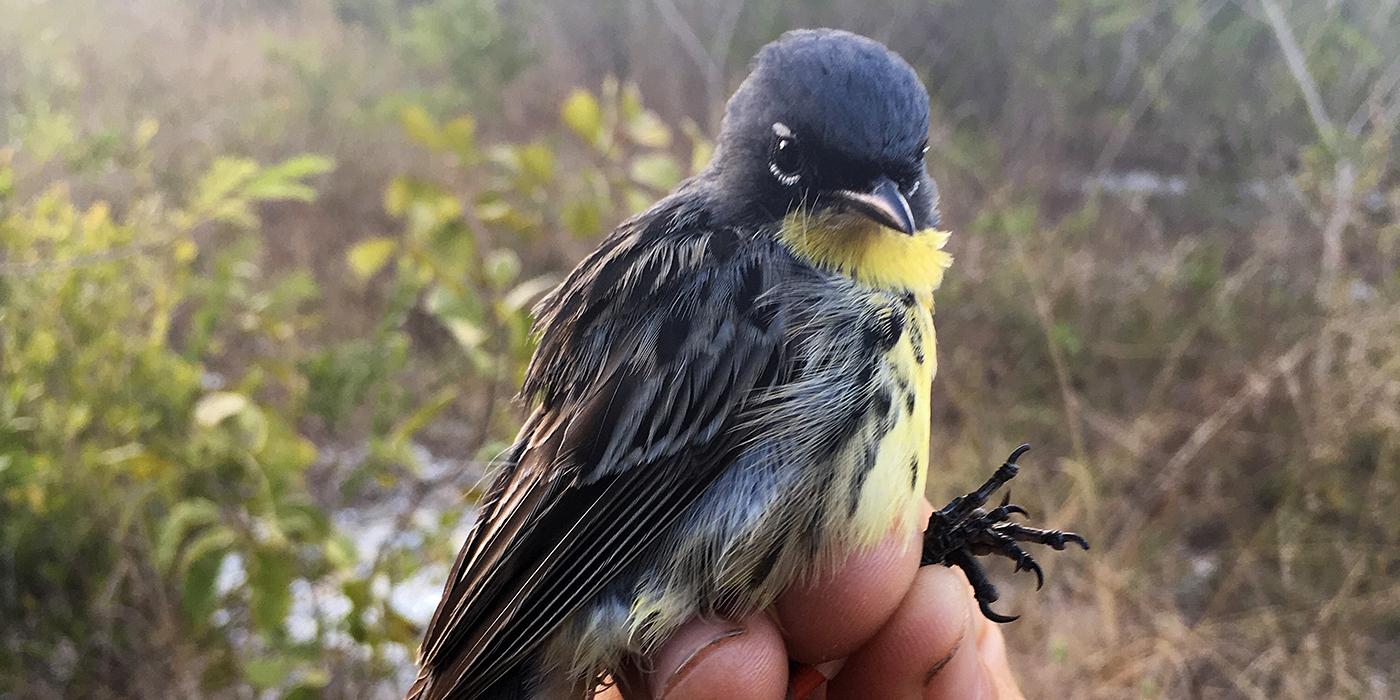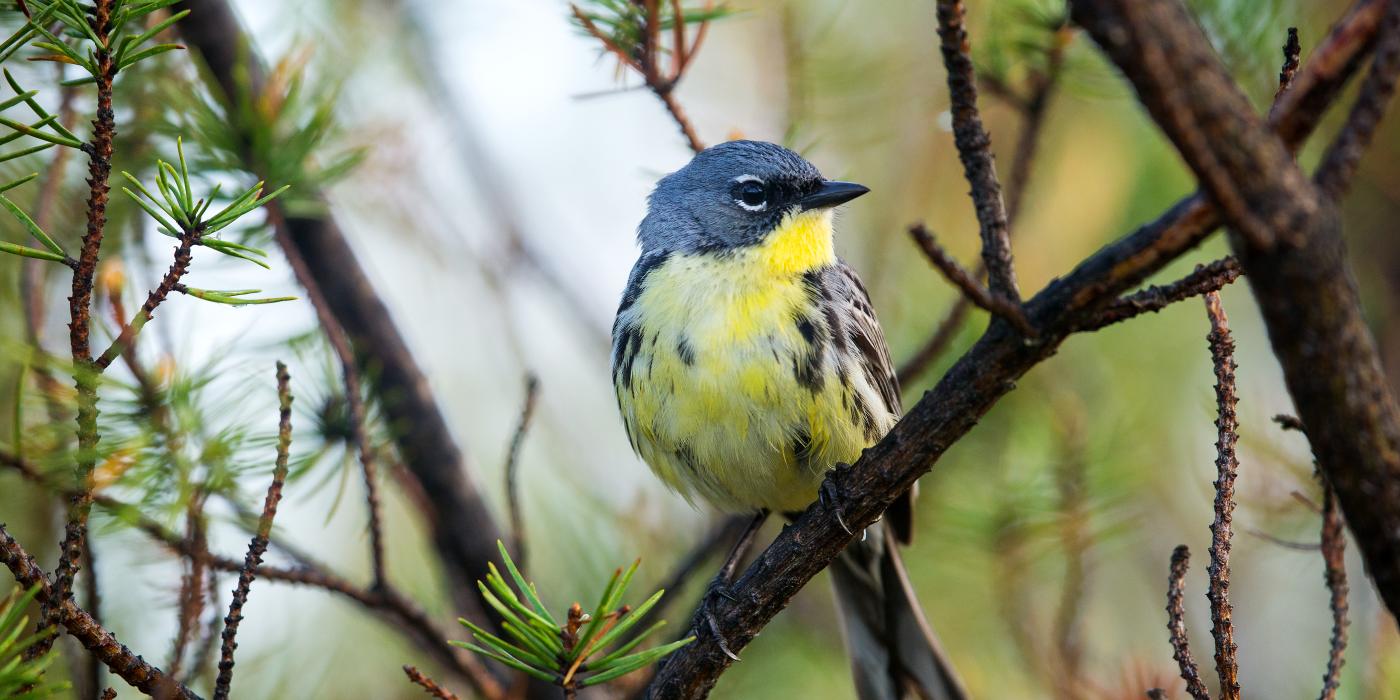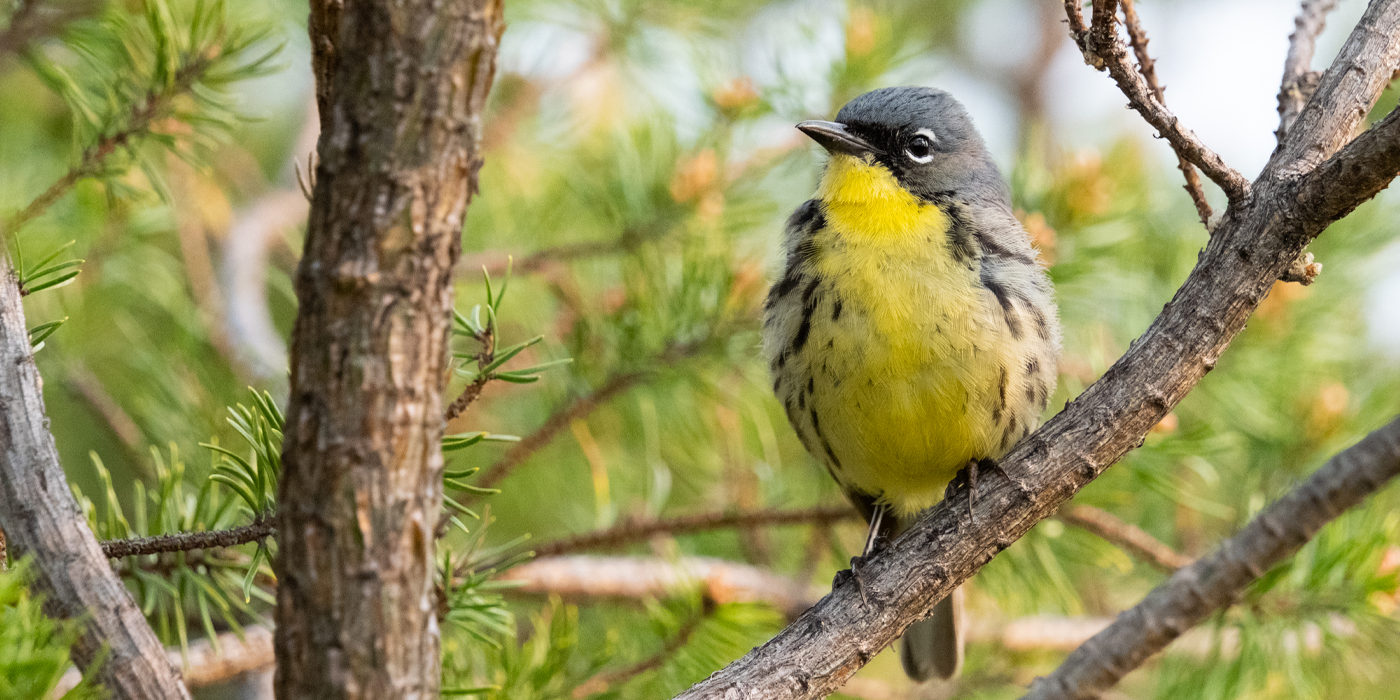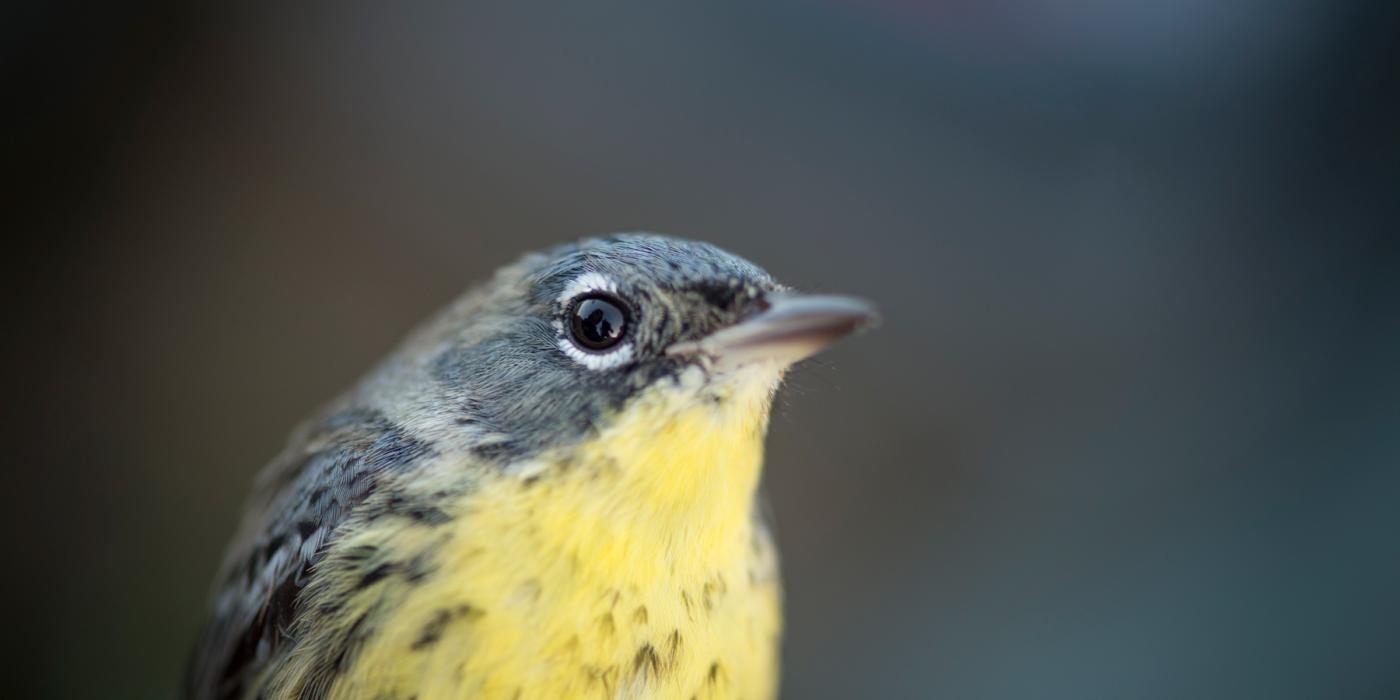Jacked about Pines
Kirtland's Warbler

Step into a jack pine forest in northern Michigan in the spring, and you will be greeted by dozens of bird songs, and one of the loudest songs will come from one of the forest's smallest inhabitants: "Choo-choo chee-chee weet-weet!"
Once you realize the singer is not in the tree right in front of you, but actually 20 yards away or more, you might see the bright yellow, black, and blue-grey plumage of a male Kirtland's warbler, singing his heart out perched at the top of one of the short, scrubby pines.
Kirtland's warblers are so abundant in some parts of this ecosystem that it is hard to believe that the Kirtland's is the rarest songbird in North America, nesting almost exclusively in about 16 counties in northern Lower Michigan.
The Kirtland's warbler (scientific name: Dendroica kirtlandii) is so rare partly because it is incredibly picky when it comes to choosing the right habitat for nesting and raising young. Scientists call species that use this type of survival strategy "habitat specialists."
In contrast to squirrels, raccoons, and starlings, which are capable of living in many different types of environments including suburban areas and backyards, the Kirtland's needs just the right type of forest in order to reproduce successfully.
They nest only in large, continuous stands of jack pine of 200 acres or more. But only if the pines are young, between 5 and 20 years old. And only if there is the right density of trees. And only if the right amount of clearings are interspersed. You might wonder how such a finicky bird could survive the process of natural selection at all!
It turns out that being an extreme specialist does have some advantages—primarily that the Kirtland's avoids competition with other bird species by using a habitat that other warblers don't use.
Insects that feast on the new pine shoots, most notably the jack pine budworm, are plentiful but few other birds are there to eat them. The low branches of the short young jack pines provide camouflage for the Kirtland's nests, which are built on the ground. The dry, sandy soils of the jack pine ecosystem drain quickly and keep the nests from flooding in summer storms. Kirtland's warblers take advantage of this unique ecosystem, but at the cost of utter dependence on a single habitat type.
The young jack pine habitat was probably never super-abundant. Jack pines are a fire-adapted species: they need to burn in order to open their cones and disperse their seeds. Then the new seedlings are able to grow quickly in areas cleared of all competition by fire and in soil rich with nutrients from the ashes. Since jack pines require fires to reproduce, the Kirtland's are fire-dependent as well.
The warblers need frequent wildfires to ensure that enough acres of jack pine habitat meet their narrow age specifications at any given time. A stand of jack pine only provides optimal breeding habitat for about 15 years. After the trees become too old, the Kirtland's move on to new areas.
In fact, one of the greatest threats to the Kirtland's survival has been modern Smokey Bear practices of suppressing natural wildfires. There are far fewer fires in Michigan forests than there were historically, which means much less habitat for the Kirtland's. And this is not the only threat they have faced.
Brood parasitism by the brown-headed cowbird—a species that has spread from the Great Plains as Michigan forests were converted to farmland—reduced Kirtland's nesting success to only 0.8 fledglings per nest in the early 1970s.
A female cowbird lays her eggs in a Kirtland's warbler nest, and the Kirtland's parents feed the cowbird hatchlings as if they were their own. The much larger cowbird chicks outcompete the warblers' own nestlings for their parents' attention, drastically lowering nesting success for the Kirtland's.
Brood parasitism and habitat loss contributed to a dangerous decline in the Kirtland's population, which decreased to fewer than 200 singing males in the 1970s. In 1972, land managers began to trap and remove cowbirds, and in 1976, they began to plant jack pine to provide good habitat for the warblers.
Currently, 150,000 acres are designated Kirtland's warbler areas, and are managed on a 50-year rotation so that 38,000 acres are of an appropriate age for nesting at all times. These measures have allowed the warbler population to rebound to an estimated 1,800 singing males in 2008, an exciting year that also saw the first recorded nests in Wisconsin and Ontario.
Kirtland's warblers typically arrive in Michigan in early May, after a 1500-mile trip from their Bahamian winter grounds, with males arriving about a week ahead of females. Males sing loudly to defend their territories and, later, to attract mates.
Females build nests on the ground, often right next to a young jack pine, by making a small cup of dried grass. She usually lays a clutch of 5 eggs, which take about 10 days to hatch. Parents feed hatchlings with insects and blueberries for another 10 days or so until they are ready to fledge.
Most pairs will start a new nest if their first one is lost to predators, and a few will have a second brood after the successful fledging of the first. Some males will even defend two separate territories, raising a family with a different female in each one, a trait known as being polyterritorial.
These multiple territories are usually not adjacent to one another, but have another male's territory in between them. One such polyterritorial male was observed singing a completely different song in each territory, perhaps to trick each female into thinking she was his only mate!
While we have a wealth of information about Kirtland's warblers during their breeding season in Michigan, we know much less about their ecology on their winter grounds in the Bahamas. In fact, until recently their wintering range was only known from a few single records.
While scientists thought Kirtland's were scattered across the 700 or so islands that make up the Bahamas, no one had ever seen multiple Kirtland's warblers wintering at the same site. That is, until the winter of 2002-2003, when a grand total of 3 were discovered by Bahamian biologists on the island of Eleuthera. A research project was initiated, and eventually about 30 birds were found, with many of them returning year after year.
We now know that the Kirtland's in winter are also dependent on early successional habitat, especially broadleaf scrub and low coppice. Just like their summer habitat, these areas are marked by frequent disturbances caused by fires and hurricanes. Surprisingly, some of the best Kirtland's habitat now occurs on goat farms—the goats eat enough vegetation so that the habitat never matures beyond the Kirtland's liking.
Like many Neotropical migrant birds, Kirtland's warblers are omnivorous in winter, consuming both insects and berries, though berries seem especially important in their winter diets. Common species of fruit consumed include wild sage, snowberry, and black torch.
Drought is common in the Caribbean in late winter, and early findings indicate that the birds readily shift locations over the course of the season as they track diminishing food resources. Winter home ranges of individual Kirtland's may overlap considerably, especially in late winter when food is most patchy and scarce. Find the areas where fruits are still available in March in April, and you will likely find the overwintering warblers.
Because Kirtland's warblers spend 7-8 months of the year in the Bahamas, it may seem obvious that the availability of good quality winter habitat is as important to their survival as summer habitat. But in reality, the ties between the breeding and non-breeding seasons for most migratory birds are not well understood. The vast majority of field studies of birds have been conducted in north temperate breeding areas, and not in the birds' southern homes.
Researchers at the Smithsonian are trying to figure out how the type of habitat the Kirtland's live in, and what they eat during the winter, affects how early they arrive up North in the spring, and how successfully they are able to reproduce.
Beginning in 2006, researchers have captured Kirtland's males arriving in Michigan in the spring, and taken samples of their blood, feathers, and toenails. The different isotopes of carbon and nitrogen in these tissues provide a "fingerprint" of that bird's winter habitat and diet.The researchers hope to determine which types of winter habitat produce the healthiest birds—those that are able to arrive soonest in the spring and have the most offspring.
If we can identify the best winter habitats, then we can work to protect or create that kind of habitat. For now, what is clear is that conservation measures in both of the Kirtland's homelands—Michigan and the Bahamas—are essential to the continued survival of this species.



